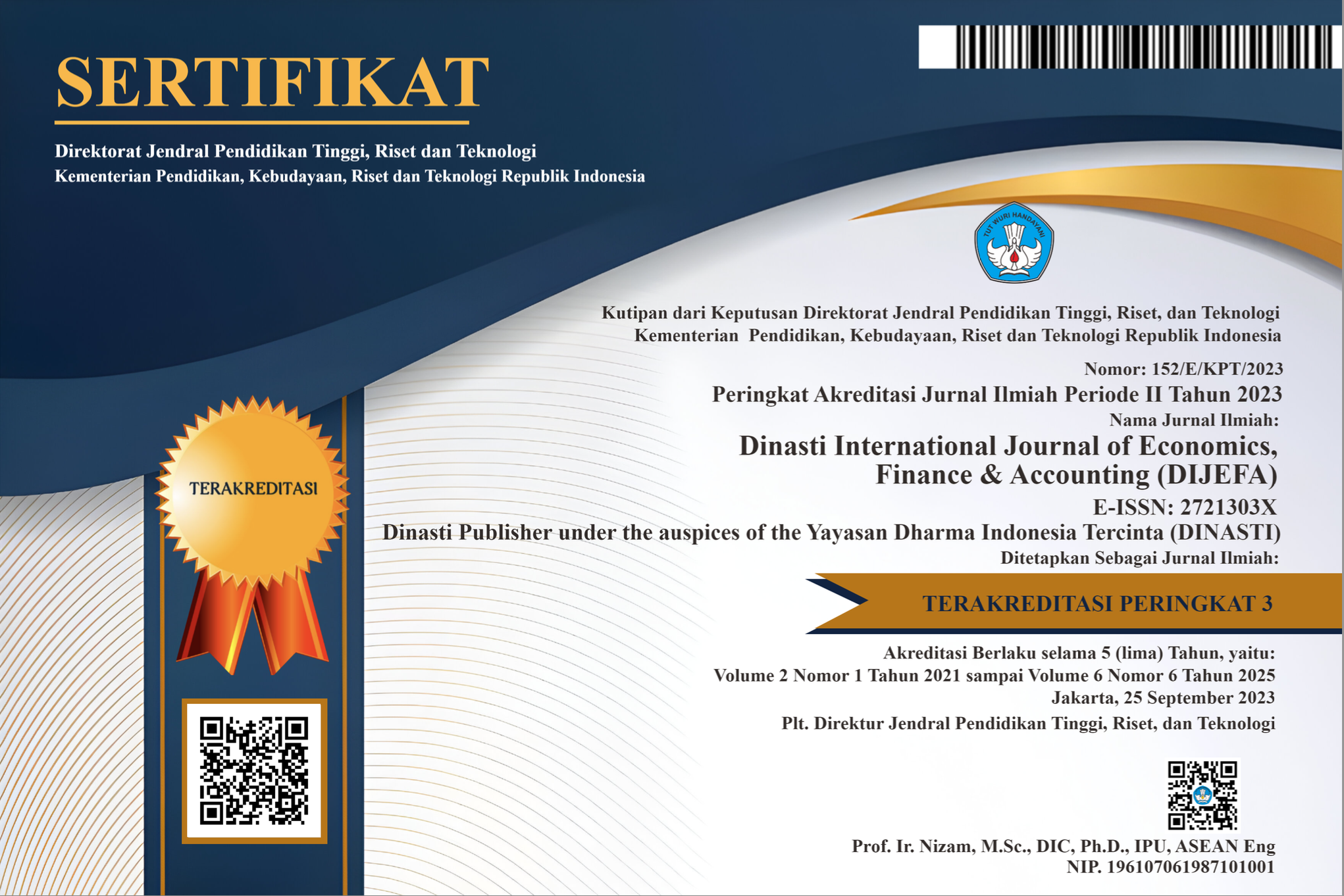The Impact of Digitalization on Women's Employment Participation in Indonesia: A Binary Logistic Regression Analysis
DOI:
https://doi.org/10.38035/dijefa.v6i2.4100Keywords:
Working Women, Digitization, Sakernas, Binary Logistics RegressionAbstract
Women's employment in Indonesia has shown a substantial increase in recent years.
Women's participation in the workforce in Indonesia continues to grow, although there is still
a significant gap compared to men. This is driven by various factors such as digitalization,
increased access to education, and policies that support women's involvement in the world of
work. This study aims to identify and analyze the factors that most affect women's participation
in the world of work in Indonesia. Using secondary data from the 2023 National Labor Force
Survey (Sakernas) with individual observations, the publication of BPS Economic Growth, the
website of the Indonesian Digital Society Index, was analyzed using binary logistic regression.
The results of the study show that education, work experience, regional classification, and
economic growth have a significant positive effect on working women while marital status, job
training, and the Indonesian Digital Society Index have a significant negative effect on working
women. This research shows the importance of a holistic approach to women's empowerment
in the world of work, which includes increasing access to education and training, creating a
supportive work environment, and utilizing technology to open up wider job opportunities for
Indonesian women.
References
Adi Rakhmawan, S. (2022). Digital Transformation of Informal Workers in the New Normal Era: "Can It Be the Solution We Are Searching For?" East Java Economic Journal, 6(2), 182–207. https://doi.org/10.53572/ejavec.v6i2.87
Bandar, N. F. A., Tay, M., Ibrahim, D. K. A., & Hassan, Z. (2016). The Relationship between Boundary Work Tactics and Work-Family Conflict among Working Women. Journal of Cognitive Sciences and Human Development, 2(1), 1–12. https://doi.org/10.33736/jcshd.357.2016
Beacom, E. (2023). Considerations for running and interpreting a binary logistic regression analysis – a research note. DBS Business Review, 5, 118–129. https://doi.org/10.22375/dbr.v5i.85
Bolli, T., & Pusterla, F. (2022). Decomposing the effects of digitalization on workers' job satisfaction. In International Review of Economics (Vol. 69, Issue 2). Springer Berlin Heidelberg. https://doi.org/10.1007/s12232-022-00392-6
Carrera, L., & Castellaneta, M. (2023). Women and cities. The conquest of urban space. Frontiers in Sociology, 8. https://doi.org/10.3389/fsoc.2023.1125439
Cazan, A. M. (2020). The digitization of working life: Challenges and opportunities. Psyhologia Resurser Umane, 18(1), 3–6. https://doi.org/10.24837/PRU.V18I1.457
Damayanti, L., & Astuti, I. P. (2024). Analysis of Determinants of Employment Opportunity Levels in West Java Province. JOURNAL OF ECONOMIC RESEARCH, 4(3), 214–228. https://doi.org/https://doi.org/10.23969/jrie.v4i3.158
Danquah, M., & Owusu, S. K. (2021). Digital technology and productivity of informal enterprises: Empirical evidence from Nigeria. WIDER Working Paper 2021/114. Helsinki: UNU-WIDER., July, 1–23. https://doi.org/https://doi.org/10.35188/UNU-WIDER/2021/054-2
Davani, I., & Sulistyaningrum, E. (2023). The Influence of Digitalization on the Absorption of Indonesian Women's Workforce. Indonesian Economic Journal, 11(3), 301–316. https://doi.org/10.52813/jei.v11i3.240
Farida, I., & Sopiah. (2022). The Influence of Work Training on Employee Performance: Systematic Literature Review. International Journal of Multidisciplinary Research and Analysis, 05(11), 3287–3296. https://doi.org/10.47191/ijmra/v5-i11-42
Jamalludin. (2024). Types of Marriage and Women's Work Participation. National Seminar on Official Statistics, 2024(1), 125–132. https://doi.org/https://doi.org/10.34123/semnasoffstat.v2024i1.2050
Lai, Y. (2023). Analysis on the Relationship between Higher Education and Women's Status. Journal of Education, Humanities and Social Sciences, 12, 180–184. https://doi.org/10.54097/ehss.v12i.7622
Mowpia. (2023). Work-Life Balance: Addressing Opportunities and Challenges for Women. International Journal for Research in Applied Science and Engineering Technology, 11(7), 295–301. https://doi.org/10.22214/ijraset.2023.54631
Munawaroh. (2021). Determinants of Working Women in West Kalimantan on the Informal Sector during Pandemic. Statistical Analysis Forum, 1(2), 81–89. https://doi.org/10.xxxxx/formasi.2021.1.1.1-12
NorehanBt Abdullah, Abdul Razak Chik, S. S. (2021). "Economic Growth, Female Labor Force Participation Andinteracting Role of Education in Developing-8 Countries: a Sustainable Development Policy Perspective." Psychology and Education Journal, 58(1), 5263–5272. https://doi.org/10.17762/pae.v58i1.2082
Ouaïmon, U.-C., & Zhang, Y. (2019). Women'S Participation in the Labor Market and Economic Development: Evidence From Eccas and Ecowas Countries. International Journal of Economic Sciences, VIII(1), 94–105. https://doi.org/10.20472/es.2019.8.1.007
Prihartanti, B. (2024). Work-Life Balance in the Lives of Working Women: A Study on Women's Experiences in the Perspective of Gender Commodity. Journal of Feminism and Gender Studies, 4(1), 40–49.
Putra, M. E. (2018). Determinantsof Urbanand Rural Youth Unemplayment Statusin Indonesia 2012-2016. Journal of Applied Economics, 3(2). https://doi.org/10.20473/jiet.v3i2.9203
Ratnaningrum, F. R., & Susanta, H. (2018). The Influence of the Dual Role of Women Workers on Employee Performance with Career Development as a Mediation Variable. Diponegoro Journal Of Social And Political, 1–9. http://ejournal-s1.undip.ac.id/index.php/
Rimkute, A., & Sugiharti, L. (2023). The Link Between Occupations, Labor Force Participation of Married Women, and Household Technology in Indonesia. Journal of Population and Social Studies, 31(September), 20–37. https://doi.org/10.25133/JPSSv312023.002
?ahin, B. (2023). The Relationshipof Women Workerswith Developmentfrom The Perspectiveof Gaining Their Economic Freedomand Securingthe Futureof Their Children. Journal of Economics and Administrative Sciences Faculty, 10(1), 745–776. https://doi.org/https://doi.org/10.30798/makuiibf.1220367
Sanjida Nowshin Mou. (2024). Women's Empowerment through Higher Education and Employment in Bangladesh. Journal of Gender, Culture and Society, 4(2), 39–66. https://doi.org/10.32996/jgcs.2024.4.2.6
Setiani Tanjung, P., Sambodo, H., & Rosiana, M. (2024). Factors that affect job opportunities in Indonesia. Journal of Equiilnomy, 6(2), 150–158. https://doi.org/10.36985/r818n720
Sharma, A. D. (2022). Technology, Women's Empowerment, and Social Transformation 1. NUTA Journal, 9(1–2), 1–8.
Siagian, A. O. (2022). Implementation of the wage sharing system and labor absorption. Madani Multidisciplinary Journal, 2(1), 217–230. https://doi.org/10.54259/mudima.v2i1.356
Sultana, T., Uddin, I., & Chowdhury, A. (2016). Female Employment: A Way to National Wellbeing. Journal of World Economic Research, 5(5), 59. https://doi.org/10.11648/j.jwer.20160505.12
Tsaniyah, A. H., & Sugiharti, L. (2021). Analysis of Female Labor Force Participation (Flfp) in East Java. Journal of Applied Economics, 6(1), 66. https://doi.org/10.20473/jiet.v6i1.26777
Vakulabharanam, V., Motiram, S., Souza, D.', Rao, S., Ravi, N., Ramnarain, S., Naidu, S., Kumar, A., Biswas, A., Folbre, N., Hartmann, B., Heim, C., Nelson, J., Ash, M., Mir, R., Boyce, J., Heintz, J., & Semieniuk, G. (2020). Gender and Work Patterns in Indian Cities: A Socio-Spatial Analysis WORKINGPAPER SERIES Gender and Work Patterns in Indian Cities: A Socio-Spatial Analysis 1 We thank Meera. Political Economy Research Institute, 525. https://www.bls.gov/sae/.
Widiani, D., & Mahfiana, L. (2023). Women in Policy: A Study of Gender Discrimination in Policy. Jurnal Darussalam: Journal of Education, Communication and Thought of Islamic Law, 12(2), 103–121. https://doi.org/10.30739/darussalam.v12i2.2310
Widyawati, & Suhermin. (2024). Digitalizationon Gender Based Job Opportunitiesin Indragiri Hilir Through DIigital Tranformation. International Conference of Business and Social Sciences, 4(1), 650–660 https://doi.org/https://doi.org/10.24034/icobuss.v4i1.549
Yeni, I., Marta, J., Satria, D., Adry, M. R., Putri, D. Z., Sari, Y. P., Akbar, U. U., & Putra, H. S. (2022). Opportunities for Working Women to Exit the Labor Market After Marriage. Indonesian Journal of Economics and Development, 22(1), 131–148. https://doi.org/10.21002/jepi.2022.08
Downloads
Published
How to Cite
Issue
Section
License
Copyright (c) 2025 Tevina Carisa Herdinanda, Happy Febrina Hariyani

This work is licensed under a Creative Commons Attribution 4.0 International License.
Authors who publish their manuscripts in this journal agree to the following conditions:
- The copyright on each article belongs to the author(s).
- The author acknowledges that the Dinasti International Journal of Economics, Finance & Accounting (DIJEFA) has the right to be the first to publish with a Creative Commons Attribution 4.0 International license (Attribution 4.0 International (CC BY 4.0).
- Authors can submit articles separately, arrange for the non-exclusive distribution of manuscripts that have been published in this journal into other versions (e.g., sent to the author's institutional repository, publication into books, etc.), by acknowledging that the manuscript has been published for the first time in the Dinasti International Journal of Economics, Finance & Accounting (DIJEFA).


























































